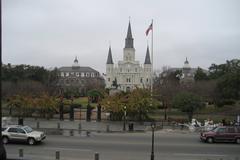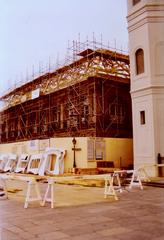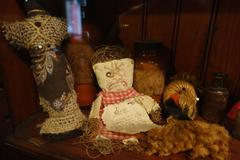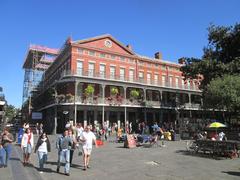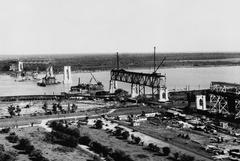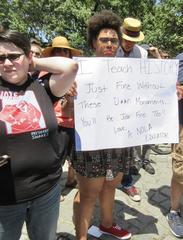Visiting Chalmette Battlefield: Hours, Tickets, and Historical Significance
Date: 20/07/2024
Introduction
Nestled just five miles downriver from New Orleans, the Chalmette Battlefield stands as one of the most significant historical sites in the United States. This battlefield is most renowned for being the site of the Battle of New Orleans, the final major battle of the War of 1812. The battle took place on January 8, 1815, and saw American forces, led by Major General Andrew Jackson, decisively defeat the British Army, commanded by Major General Sir Edward Pakenham. This victory bolstered American morale and nationalism, despite the Treaty of Ghent being signed on December 24, 1814. The Chalmette Battlefield is not only a symbol of American resilience but also a testament to the strategic importance of New Orleans and the Mississippi River during the early 19th century (National Park Service). Today, the site is preserved as part of the Jean Lafitte National Historical Park and Preserve, offering visitors a comprehensive look at this pivotal moment in American history through guided tours, reenactments, and educational programs (History.com). This guide will provide all the essential information you need to make the most of your visit to Chalmette Battlefield.
Table of Contents
- Introduction
- Historical Background of Chalmette Battlefield
- Preservation and Commemoration
- Archaeological Discoveries
- Visitor Information
- Educational Programs and Resources
- Frequently Asked Questions (FAQ)
- Conclusion
Historical Background of Chalmette Battlefield
The Battle of New Orleans
The Chalmette Battlefield is renowned for being the site of the Battle of New Orleans, a pivotal conflict during the War of 1812. The battle took place on January 8, 1815, and was the final major battle of the war. Despite the Treaty of Ghent being signed on December 24, 1814, the news had not yet reached the combatants in New Orleans. The American forces, led by Major General Andrew Jackson, decisively defeated the British Army, commanded by Major General Sir Edward Pakenham. This victory significantly bolstered American morale and nationalism (National Park Service).
Strategic Importance
The strategic importance of the Chalmette Battlefield lay in its location. Situated just five miles downriver from New Orleans, it was a critical point for defending the city from British invasion. The Mississippi River, a vital artery for trade and transportation, made New Orleans a valuable target. Control over New Orleans meant control over the river, which was essential for the economic and military logistics of the time (History.com).
The Forces Involved
American Forces
The American forces comprised a diverse group of soldiers, including regular U.S. Army troops, state militia units, free African Americans, Native Americans, and even pirates led by the infamous Jean Lafitte. The total number of American troops was approximately 4,500. Andrew Jackson’s leadership and the effective use of fortifications and artillery played a crucial role in the American victory (Smithsonian Magazine).
British Forces
The British forces, numbering around 8,000, were seasoned veterans who had fought in the Napoleonic Wars. Despite their experience and numerical superiority, they faced significant challenges, including difficult terrain and strong American fortifications. The British suffered heavy casualties, with over 2,000 soldiers killed, wounded, or captured, including Major General Pakenham, who was killed in action (Britannica).
Aftermath and Significance
The Battle of New Orleans had far-reaching consequences. Although it occurred after the peace treaty was signed, the victory was celebrated as a defining moment in American history. It propelled Andrew Jackson to national fame, eventually leading to his presidency. The battle also demonstrated the effectiveness of a diverse fighting force and the importance of strong leadership and strategic planning (Library of Congress).
Preservation and Commemoration
Establishment of the Chalmette Battlefield
The Chalmette Battlefield was designated as a national historical park in 1939 to preserve the site and commemorate the battle. It is now part of the Jean Lafitte National Historical Park and Preserve. The park includes the battlefield, the Chalmette National Cemetery, and the Malus-Beauregard House, offering visitors a comprehensive understanding of the historical events that took place (National Park Service).
Annual Reenactments and Events
Each year, the Chalmette Battlefield hosts reenactments of the Battle of New Orleans, attracting history enthusiasts and tourists. These events provide a vivid portrayal of the battle, complete with period costumes, weaponry, and tactics. The reenactments serve as an educational tool, bringing history to life and fostering a deeper appreciation for the significance of the site (New Orleans Historical).
Archaeological Discoveries
Over the years, numerous archaeological excavations have been conducted at the Chalmette Battlefield, uncovering artifacts that provide insights into the lives of the soldiers and the conditions they faced. Items such as musket balls, uniform buttons, and personal belongings have been found, offering a tangible connection to the past. These discoveries have been crucial in piecing together the events of the battle and understanding the experiences of those who fought there (Louisiana Archaeological Society).
Visitor Information
Chalmette Battlefield Visiting Hours and Tickets
The Chalmette Battlefield is open to visitors year-round. The operating hours can vary based on the season, so it is advisable to check the National Park Service website for the most current information. Admission to the battlefield is free, but guided tours and special events may have associated costs.
Travel Tips
- Getting There: The battlefield is easily accessible by car from New Orleans. Public transportation options are also available.
- Best Time to Visit: The site can be visited year-round, but the annual reenactments in January offer a unique experience.
- Nearby Attractions: Consider visiting other historical sites in New Orleans, such as the French Quarter and the National WWII Museum.
- Accessibility: The park is wheelchair accessible, with paved paths and accessible restrooms.
Educational Programs and Resources
The Chalmette Battlefield offers a range of educational programs and resources for visitors of all ages. Guided tours, interactive exhibits, and educational workshops are available to enhance the visitor experience. The park also provides resources for teachers and students, including lesson plans and educational materials that align with curriculum standards. These programs aim to educate the public about the historical significance of the site and the broader context of the War of 1812 (National Park Service).
Frequently Asked Questions (FAQ)
Q: Are there any guided tours available at the Chalmette Battlefield?
A: Yes, guided tours are available and can provide a more in-depth understanding of the site’s history.
Q: Can I bring my pet to the Chalmette Battlefield?
A: Pets are allowed on the grounds but must be kept on a leash. Pets are not permitted inside buildings.
Q: What are the best photographic spots at Chalmette Battlefield?
A: The Malus-Beauregard House and the battlefield monuments offer excellent photography opportunities.
Conclusion
The Chalmette Battlefield stands as a testament to a pivotal moment in American history. Its preservation and the ongoing efforts to educate the public ensure that the legacy of the Battle of New Orleans and the diverse group of individuals who fought there will not be forgotten. The site continues to attract visitors from around the world, offering a unique opportunity to explore and understand a crucial chapter in the nation’s past.
References
- National Park Service, 2023 https://www.nps.gov/jela/chalmette-battlefield.htm
- History.com, 2023 https://www.history.com/topics/war-of-1812/battle-of-new-orleans
- Smithsonian Magazine, 2023 https://www.smithsonianmag.com/history/the-battle-of-new-orleans-180964118/
